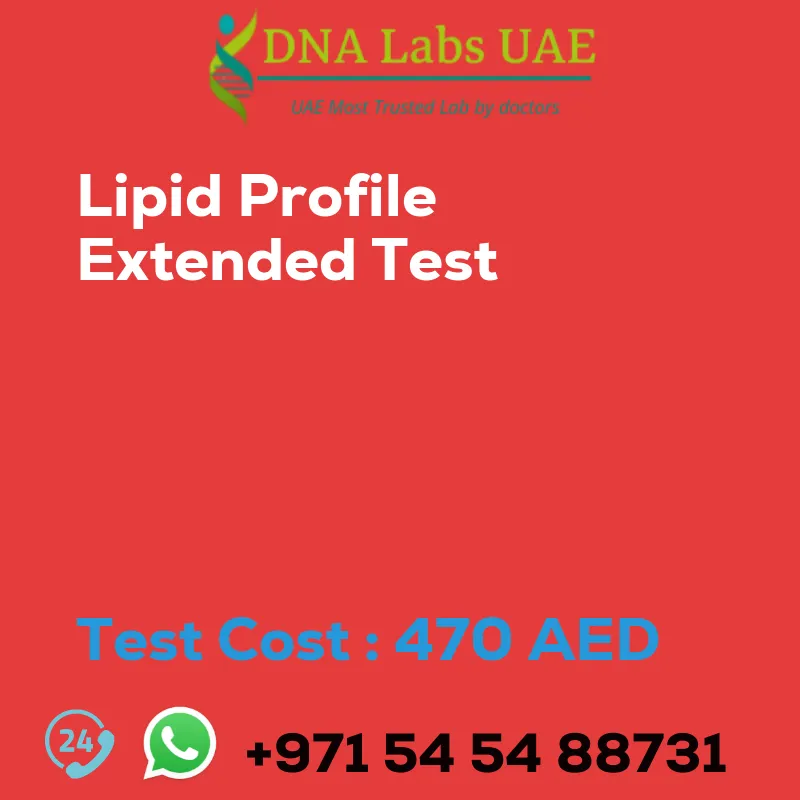LIPID PROFILE EXTENDED Test
Components:
- Apolipoproteins A1, B & Ratio
- Lipoprotein (a)
- Cholesterol
- Triglycerides
- HDL
- LDL
- Cholesterol / HDL Ratio
- Non HDL Cholesterol
- Cardio CRP
Price: 470.0 AED
Sample Condition: 3 mL (2 mL min.) serum from 1 SST. Ship refrigerated or frozen. Minimum 12 hours fasting is mandatory. Grossly hemolysed samples are not acceptable.
Report Delivery: Sample Mon through Sat by 4 pm; Report Same day
Method: Spectrophotometry, Immunoturbidimetry, Nephelometry
Test type: Heart diseases
Doctor: Cardiologist, Physician
Test Department:
Pre Test Information: Minimum 12 hours fasting is mandatory.
Test Details:
The LIPID PROFILE EXTENDED test is a blood test that measures various components of lipids (fats) in the blood. It provides a comprehensive assessment of an individual’s lipid levels and helps in evaluating their risk for cardiovascular diseases.
The test typically includes the measurement of the following components:
- Total Cholesterol: This measures the total amount of cholesterol in the blood, including both high-density lipoprotein (HDL) cholesterol (good cholesterol) and low-density lipoprotein (LDL) cholesterol (bad cholesterol).
- HDL Cholesterol: This measures the level of good cholesterol in the blood. Higher levels of HDL cholesterol are associated with a lower risk of heart disease.
- LDL Cholesterol: This measures the level of bad cholesterol in the blood. High levels of LDL cholesterol can contribute to the development of plaque in the arteries, increasing the risk of heart disease.
- Triglycerides: This measures the level of another type of fat in the blood. High levels of triglycerides are also associated with an increased risk of heart disease.
- Non-HDL Cholesterol: This calculates the total cholesterol minus the HDL cholesterol. It provides an estimate of the amount of bad cholesterol in the blood.
- VLDL Cholesterol: This measures the level of very low-density lipoprotein cholesterol, which is another type of bad cholesterol.
By assessing these lipid levels, healthcare providers can determine an individual’s overall lipid profile and evaluate their risk for cardiovascular diseases such as heart attack or stroke. Based on the results, lifestyle modifications, medication, or further testing may be recommended to manage and reduce the risk of these conditions.
| Test Name | LIPID PROFILE EXTENDED Test |
|---|---|
| Components | *Apolipoproteins A1, B & Ratio*Lipoprotein (a)*Cholesterol*Triglycerides*HDL*LDL *Cholesterol / HDL Ratio*Non HDL Cholesterol*Cardio CRP |
| Price | 470.0 AED |
| Sample Condition | 3 mL (2 mL min.) serum from 1 SST. Ship refrigerated or frozen. Minimum 12 hours fasting is mandatory. Grossly hemolysed samples are not acceptable. |
| Report Delivery | Sample Mon through Sat by 4 pm; Report Same day |
| Method | Spectrophotometry, Immunoturbidimetry, Nephelometry |
| Test type | Heart diseases |
| Doctor | Cardiologist, Physician |
| Test Department: | |
| Pre Test Information | Minimum 12 hours fasting is mandatory. |
| Test Details |
The LIPID PROFILE EXTENDED test is a blood test that measures various components of lipids (fats) in the blood. It provides a comprehensive assessment of an individual’s lipid levels and helps in evaluating their risk for cardiovascular diseases. The test typically includes the measurement of the following components: 1. Total Cholesterol: This measures the total amount of cholesterol in the blood, including both high-density lipoprotein (HDL) cholesterol (good cholesterol) and low-density lipoprotein (LDL) cholesterol (bad cholesterol). 2. HDL Cholesterol: This measures the level of good cholesterol in the blood. Higher levels of HDL cholesterol are associated with a lower risk of heart disease. 3. LDL Cholesterol: This measures the level of bad cholesterol in the blood. High levels of LDL cholesterol can contribute to the development of plaque in the arteries, increasing the risk of heart disease. 4. Triglycerides: This measures the level of another type of fat in the blood. High levels of triglycerides are also associated with an increased risk of heart disease. 5. Non-HDL Cholesterol: This calculates the total cholesterol minus the HDL cholesterol. It provides an estimate of the amount of bad cholesterol in the blood. 6. VLDL Cholesterol: This measures the level of very low-density lipoprotein cholesterol, which is another type of bad cholesterol. By assessing these lipid levels, healthcare providers can determine an individual’s overall lipid profile and evaluate their risk for cardiovascular diseases such as heart attack or stroke. Based on the results, lifestyle modifications, medication, or further testing may be recommended to manage and reduce the risk of these conditions. |








